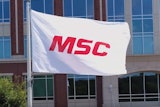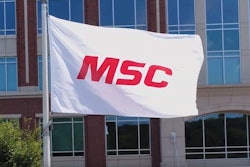Spring and fall herald pleasant weather in many areas, with warm days and cool nights. However, the same combination that makes outdoor activities pleasant can wreak havoc in industrial facilities. Temperature and humidity swings create condensation on concrete slab floors common in many industrial settings. Known as “sweating slab,” this sheen of water can cause big issues with employee safety and product integrity.
Following are a few of the common questions about sweating slab, and an example of a company that successfully solved its perspiration problem.
What is sweating slab?
Condensation occurs when warm, moist air contacts a cold surface. As the air becomes colder, it loses its ability to store moisture. In the spring and fall, temperature swings and the accompanying condensation on concrete floors can cause problems in workplaces worldwide, resulting in serious worker risk, operational issues and product loss.
What causes sweating slab?
According to Peter Craig, founder of Concrete Constructives, “the two major causes of slab surface sweating are classic dew point and hygroscopic activity outside of classic dew point parameters.”
Hygroscopic activity involves substances, particularly soluble salts, in and on the surface of the slab drawing moisture from the air to the surface of the slab. Dew point related issues occur when the surface of the concrete slab is at or below the saturation point of the air. In the spring, a concrete slab will trail the air temperature by about a month. So while the April air is a balmy 72, the slab might still be stuck in March at 50 F. Warm air sits on this cold slab, dropping moisture as it cools.
What safety issues are caused by sweating slab?
Both foot and forklift traffic can become perilous when the surface is slippery. While many warehouses endeavor to create smooth floor surfaces for efficient movement, having a smooth floor can compound the effects of seasonal condensation.
According to the National Floor Safety Institute, the majority of workers' compensation claims are attributed to employees slipping on slick floors1, and are the leading cause of occupational injury for people aged 15-24 years. Falls account for over 8 million hospital emergency room visits, representing the leading cause of visits (21.3%). Slips and falls account for over 1 million visits, or 12% of total falls.
What product integrity issues are caused by sweating slab?
Many warehouse spaces develop condensation problems when cold materials, such as metal, are brought into a warmer space. It may take hours or even days for the temperature of the delivered product to approach the inside air temperature.
During this warm-up period, the item’s surface temperature is initially below the dew point temperature of the air, leading to condensation on the surface. This moisture can lead to corroded metal, damp packaging and paper, and a host of other issues.
What are some sweating slab solutions?
Some successful tactics to minimize condensation are:
- A dehumidification system (air conditioning) to decrease the moisture content of the air.
- A heating system to increase the air temperature or surface temperature.
- Air movement across cold surfaces to increase the surface temperature and decrease the amount of time that warm air is in contact with cold surfaces.
Because large industrial spaces are often impractical, or at very least expensive to heat and cool, air movement is both the simplest and most affordable solution.
Heat transfer from the air to the surface can occur up to 2.5 times faster by increasing the air speed by 100 feet per minute (1.2 miles per hour).2 A faster warm-up time coincides with less condensation and less chance for corrosion.
Large diameter, low speed fans thoroughly and gently mix the air, sending warm air down from the rafters. This results in only slight temperature differences from floor to ceiling and wall to wall and the elevated air speed needed to reduce condensation at the floor.
Case in point
Any change in humidity or weather caused the warehouse’s concrete floor to sweat at Charlotte, N.C., HVAC equipment distributor N.B. Handy. This created a standing puddle that was referred to as “Lake Handy.”
“The forklifts were unsafe to drive because they couldn’t stop, and people would slip on the water,” said N.B. Handy Operations Manager Blake Boleman. “We had one forklift go through the wall into our sales room—luckily, no one was hurt. The products would get water on them too.”
Ultimately, N.B. Handy installed six 20-ft. diameter Big Ass Fans and said goodbye to their watery woes
After they installed the large diameter, low speed fans, “Lake Handy” experienced a record drought, drying up completely and creating safer working conditions.
“The fans have helped solved our problems,” Boleman said. “I couldn’t be happier.”
Conclusion
Big Ass Fans reduce concrete sweat by moving stagnant air off the cold surface before it has a chance to cool down enough to leave telltale puddles behind. Thoroughly mixing the air within the space will also help to raise the slab temperature more quickly, shortening the season for condensation. Big Ass Fans also improve worker comfort year round and save heating costs in the winter, providing the most economical and effective solution to reduce surface slab sweating and condensation.
1. Industrial Safety & Occupational Health Markets 5th edition
2. 2003 ASHRAE Applications Handbook, pp. 4-6.
Erin Hsu is senior copywriter for Big Ass Fans, a designer and manufacturer of large diameter, low speed fans.























